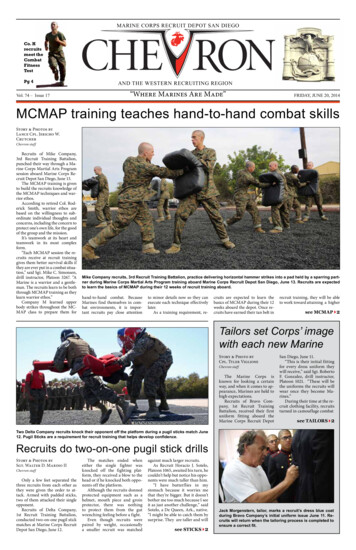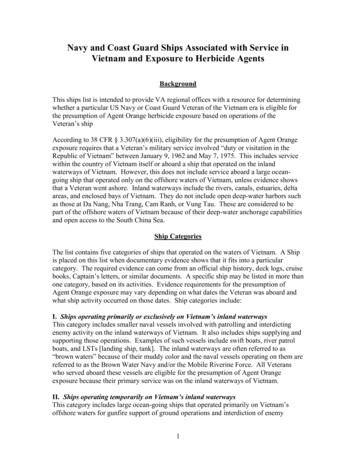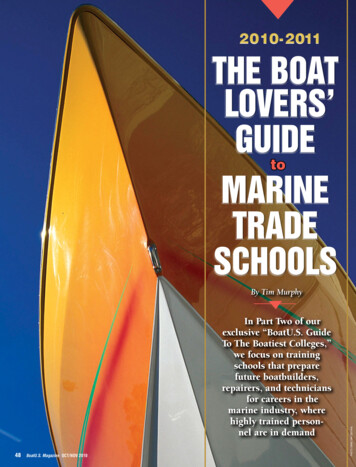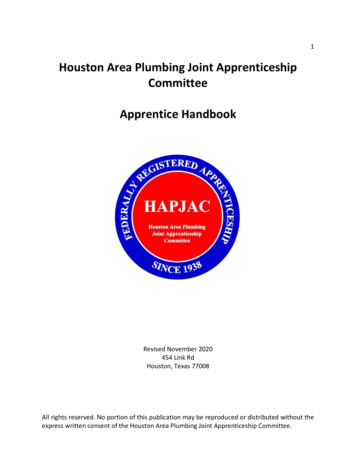
Transcription
March, AS 42Welcome Aboard –And Welcome Back!The IVORY TOWER is the publication of the College of St Ursula, the Sydney University branch of the Society for Creative Anachronism, Inc, PO BOX 403, Wentworth Building,Sydney University, NSW 2006. It does not delineate SCA policy, nor that of the University of Sydney and its Union. The Logo and inspiration for the layout is courtesy of Leon Spencer.Unless otherwise specified, copyright remains with the artist/author and artworks/articles may only be reproduced with the permission of the artist/author. Please contact the Chronicler.
Your Officers for this FlightAmelineSeneschalPresident(Catherine Farmer)seneschal@ursula.sca.org.au0405 264 291LijsbetA&S Officer (and rapier)Secretaryartsci@ursula.sca.org.au0422 462 378ReeveTreasurerreeve@ursula.sca.org.au0410 405 434(Louise Beange)Yael(Yael Bornestein)Ruth(Jess Moreton)Jan(Chris Collins)Lachlan(Rowan Lawrence)Lyndsay(Lyndsay Scherini)Heraldherald@ursula.sca.org.au0433 995 841Marshal(and web and archery and constab)marshal@ursula.sca.org.au0418 625 283Hospitallerhospit@ursula.sca.org.au0408 646 087Chroniclerchron@ursula.sca.org.au0425 296 725
Some Words from Our LeaderGreetings, fair readers. By the fact that you have this inyour hands, we can assume that you’ve joined theCollege of St Ursula: and Her 11,000 Virgins andMartyrs – the Society of the Creative Anachronists, theSCA. I congratulate you on your choice.The SCA isn’t just Sydney University Students – it is aworldwide society, which can loosely be described asbeing devoted to recreating the Medieval Era. The SCAis what you make of it: socializing, combat, learning,making, drinking But whatever you want to makeof it, there will be people there to help you achieve– whether that be learning to fight with sword or bow,or create a Viking tunic, or brew the perfect mead– and then the new friend to drink it with – the SCA isfull of people who want to help you.And I challenge you to find a more welcoming group.If you let them, you have just joined a society of lifelong mentors – and friends. It will all seem a bit weirdat first, eccentric, wacky perhaps – but as someone whofirst stepped up to the SCA a year ago exactly, whostood as perhaps you stood, nervous about approachingthese strange people in funny clothes, I can promiseyou that you will have no need to regret it. Whateveryou hope to find, we want to help you find it. First andforemost, we are a society of friends. Welcome to ournumber.- AmelineAmeline Giffard, Seneschalseneschal@ursula.sca.org.auSo, You’re New?Then come to Newcomer’s Feast! It’s the first big feast of the year, and designed to give you an insight intowhat, exactly, our odd little group is all about. There’ll be a heavy fighting tourney, as well - details will beannounced on the list.Date:Saturday 24 March, 2007Time:6:00 pm - 11:00 pm Feel free to rock up a bit earlier and help out - it’ll give you a good idea of what, exactly, goes on behind the scenes, and a chance to socialise with some cool people.Place:Imar Community Centre, Fitzroy St, Croydon. This is easily visible from the train station (around a 30secwalk)Cost: 15 for new members and booked members, 20 for booked non-members, 5 surcharge for not booking(new members excepted).Organizer:Ameline Giffard ( seneschal@ursula.sca.org.au ) Let her know if you have any dietary requirements, or ifyou have any further questions.
Meet The OfficersMarshal (And Webminister, Constable, Captain of Archers.)Hail and well met. Welcome to the College of St Ursula. My name is Jan(pronounced ‘yan’) and I am the college’s marshal, constable and webminister.I’ve only been involved for a relatively short while (only for the last twoyears), but I’ve enjoyed myself a fair bit and am quite involved in archeryand combat activities. I was previously the college’s Captain of Archersbefore I accepted the post of Marshal.As college marshal, I’m here to provide you with information and resources on combat, archery and related activities in our glorious society.Whilst I do not know much about the art of fence, our captain of fence,Lijsbet van den Kerk, can assist where I cannot. I also keep and maintainthe college’s archery equipment and the college arrows (both combat andtarget).As the college constable, I look after general safety and security at events,look after lost property, make sure people sign the required mundaneanarshalpaperwork and encourage people to prevent mundane life intruding intomarshal@ursula.sca.org.auevents.J ,MAs the web-minister, I maintain the College web-site where you can find the contact details for all the current officers, articles written by collegians, both past and present, and references to other materials whichyou may find of use in the SCA.I hope to see you all enjoying your time with us in the College of St Ursula. I hope to see some of you getting involved in target archery or combat in the not to distant future.- Jan.
A&S Officer (And Rapier Marshal, too!)Hi, I’m Louise, officially known as Lijsbett van den Kerk, yourfriendly Arts and Sciences Officer. A&S covers just about everyactivity in the society that isn’t fighting. This includes everythingfrom making clothing and armour to cooking and brewing to singing, dancing, leatherwork, jewelry making you get the idea. If itwas done in the Middle Ages, you can find it here.I’ll be running weekly meetings on campus during semester forpeople to get together, chat and work on projects (the well renowned ‘stitch and bitch’) as well as organising classes on anyarea of A&S you may be interested in. Feel free to suggest anythingyou want to know more about, or ask me any questions you mayhave about Medieval arts and sciences, or the SCA in general. Staytuned to the mailing list for classes on basic armouring, how tobrew your own mead and beer, making shoes and pouches, clothing design and sewing, and many more.Yours in Service- LouiseLijsbett, A&Sartsci@ursula.sca.org.auThe Poor, Overworked ReeveWelcome to the SCA!I’m your Nameless Reeve, but I also respond to Yael (pronounced “ya-el,” not “yale”). Hopefully the namelessness won’tbe for long. I keep the books. Anything to do with funding ismy responsibility.Since I have this dry and often thankless task, you probablywon’t see as much of me as some of the other officers, but feelfree to chat to me when you do.For any questions you can contact me on reeve@ursula.sca.org.au- YaelYael, Reevereeve@ursula.sca.org.auHave you joined our mailing list?Go to ’ll tell you everything you need to know(and some things you don’t)
HospitallerHi, I’m Lachlan, the college hospitaller. That’s medieval-speak for“person who helps new members anddeals with / distributes the college’sspare stuff to those who need it”. Myjob is to help you, and I should explain the two ways in which I do so.First, if you need information aboutanything SCA-related, I’m your man.Whether it’s about who we are, whenwe meet, what we do, or anything ofthe sort, chances are either I can fillyou in, or, (for the more tricky questions) find someone who can on shortnotice. Of course, there are manyhelpful people in the SCA, but it’s nottheir job, they’re just really nice people. It *is* my job, so do not hesitateto contact me with any questions youmight have. For preference, contactme by e-mail (hospit@ursula.sca.org.au).Lachlan, Hospitallerhospit@ursula.sca.org.auSecond, when you decide our club sounds awesome and you want to go to an event, I’m your best friend,because if there’s stuff you don’t have, but need (for example, medieval clothes, a.k.a. “garb”, for a feast),it’s my job to try to get that stuff together out of the college’s resources for you to borrow. This is not aguarantee that you can borrow anything and everything, but I’ll try to get you what you need.Incidentally, I’ve been in the college for 4 years now, and have, in that time, done rather a lot of heavy armoured fighting. Hence, though it’s not strictly part of my job, I am also happy to help out with giving outinformation on / getting people into heavy armoured combat.- LachlanChroniclerWelcome to the College of St Ursula!I’m your friendly college chronicler, and putting together Ivory Tower is my main job. If you ever haveanything you’d like to get published (notices, events, articles, comics, puzzles.) I’m the person to speak to.If in your travels you find articles or photos that you think deserve to be published here, by all means, let meknow! Otherwise, I’ll have to pester people for them. I’d like to say thanks to Ameline and Lillith for helping put this issue together, and I’m looking forward to meeting lots of new faces (although you won’t see mearound much).-LyndsayHave you been to our (brand spankin’ new) website?Find it at http://ursula.sca.org.au
So, What’s the Deal with all the Violence? A FAQWhat exactly do you do? I’ve seen you guys hitting each other with sticks, playing with swords, and holding bows menacingly. How does it all work?We have three main types of combat disciplines. Here’s a brief run-down of each:Heavy Infantry Fighting: Think Braveheart, or A Knight’s Tale. Full contact martial sport using heavyarmour (usually about 20kg) andrattan weapons (Rattan looks likebamboo but has solid core, alsoused for furniture and Kendoswords). Very popular, and has theadded bonus of being the combatform that is used to determine whogets to be King/Queen. Both singlecombat and massed combat (eveninvolving archers) are popular forheavies.Light Fighting: Think RobinHood, or Henry V. Archery (using30 pound bows and arrows withrubber “blunts” on the businessends), axe- and javelin-throwing,non-contact fighting.Lights participate in wars, shooting / throwing at heavies and eachother. Less armour is needed than in Heavy fighting, because you will not be involved in melee fighting (youwon’t be hit with sticks, just shot at etc.). Lots of fun, easy to get involved in, and great if you don’t want tobe *too* close to the action while still getting in on the entertainment.Rapier Fencing: Think Three Musketeers, or Pirates of the Caribbean Fighting with blunted steel swords.Think modern fencing but much more freeform: you can use two swords, rapier and dagger, cloak and dagger, etc., and you can move sideways around your opponent instead of just fighting in a straight line.Isn’t it dangerous?Not really – we see less injuries than Football or Rugby. Because we are aware of the dangerous nature of
combat sports, we have very effective safety rules and procedures, and nobody canfight without first proving they are safe on the field.How does it work? How do you know who wins, and how difficult is it?All our fighting works on a simple but effective honour system, backed up by peoplecalled “marshals” who help adjudicate. When you are first trained to fight, you aretaught “calibration”: how hard you have to be hit for that hit to count. If you arehit that hard in a “fatal” area (head, neck, torso), you “die” (shout out “good”, as in“good hit”, and fall over). If you are hit that hard in a non-fatal area (arm or leg), youforfeit the use of that limb (E.G. dropping to your knees or holding an arm behindyour back).If you don’t think the hit was hard enough, your opponent will try to hit you progressively harder until youdo – so cheating is really silly and tends to end in a painful experience for the cheat. For light infantry,because they cannot be “hit” by a heavy, they are killed either by being shot/hit with a missile weapon, or byhaving a heavy walk within 5 metres of them, show the light that they are holding a weapon, and loudly say,“My lord/lady, You are Slain!” or something very similar to the same effect.Can people like me get involved?Yes! The more the merrier! All our combat forms are unisex, and there are a number of good female fightersin every discipline. Don’t think you have to be tall, strong, or co-ordinated to play, either: some of the bestfighters are small, and you will learn how to be more co-ordinated as you go. Also, the SCA is an entirelynon-denominational group: we won’t preach at you, we’re not a cult, and we have members from a verywide range of backgrounds.Isn’t it expensive, then?That depends on you. To start off,you can borrow equipment until youdecide whether you want to continuewith fighting. After that, you couldget together a simple, but effectiveHeavy kit for around 250-350 ifyou’re willing to help make it (we’llteach you how to make it as well), orbuy a set of beautiful full plate armourfor 2000 : it depends on your budget. For light, costs are considerablyless, around 100-200 at the cheapest,more if you want nice kit. For rapier,it varies, but it tends to be around thesame as heavy, if not a bit less, for avery basic kit.So, how do I get involved?Contact your friendly college Marshal(Jan, email: marshal@ursula.sca.org.au), and we’ll tell you all the details and give you a hand with anythingyou need. Alternately, you can always turn up at Rowany Fighter Practice (Burwood Cultural and Community Centre (aka the Double Hall, aka the old Masonic Hall) at Belmore Road, Burwood. Monday night,7.30pm until late.)Lachlan de Hameldone
So, What is this SCA Thing Anyway?1. What is the SCA?The SCA is the Society for Creative Anachronism. It is a recreational group focussed on recreating aspectsof life before 1600.For the most part, members research andconstruct clothing, weaponry and other itemsfrom the Middle Ages and Renaissance, withEurope being the centre of our attentions. Formost of the Middle Ages, the Middle Eastand North Africa were such important tradepartners with Europe (and everyone invadedeveryone else so frequently) that there is noborder drawn between modern Europe andthese territories. Some members also dabblein Roman reconstruction, whereas others prefer Eastern (Chinese, Japanese, Mongolian).We have a broad range of activities rangingfrom fighting with practice swords, throughcostuming, brewing, cooking, dancing,singing and music to textile, equestrian andacademic research. Our official events areconducted in period clothing (called garb) andare a cross between a giant dress-up party anda huge game of Pretend.The SCA was started by a group of medievalhistory students in Berkeley in 1966 and nowhas over 30,000 paying members world-wide,with an estimated 60,000 more participants.While the College of St Ursula is for SydneyUni students, SCA members come from allwalks of life and across all age groups, with alot of family participants.Helene and Hrothgar,your Baroness and Baron2. Hang on, I thought you were a Sydney University club?Well, we are. The College of St Ursula is a registered SU club that is affiliated to the Australian and International SCA. Our fees are much cheaper and our first responsibilities are to the university, but aside from thatwe interact pretty freely with the local SCA branches, especially the Barony of Rowany (Sydney region).3. Sounds a bit hippy, doesn’t it?Yeah, you’ve busted us. The founding crew were all a bunch of unreconstructed hippies who went on to dothings like write best-selling fantasy novels and found IT companies. To this day there are an awful lot ofcaring Californianisms in the governing documents of the organisation.But we’ve managed to survive over 40 years, so it’s hippy mixed with practicality. We try not to talk aboutmodern politics, and there is a Society-wide injunction against official religious positions (you can believewhatever you like, we just don’t care).4. So what do you actually do?Medieval stuff. We dress up in period garb for official events and spend our time there doing everythingfrom singing and feasting on medieval food to hitting each other in the (armoured) head with sticks. It’s
totally up to you. “If they did it then, we tryto do it now, except we don’t have the Plague,we do have equality and we like flushingtoilets”.At our (ungarbed) meetings, we sit aroundand plan cunning new things and projects andshare research and tell tales of what we’vebeen up to. Basically it’s a social-club meetscraft-group meets martial art meets Lord ofthe Rings. And yeah, it will come as no surprise to learn that those Berkeley hippies wereall Tolkien freaks, too. But you’re welcome toembrace whichever bits take your fancy andignore the rest, just no elf ears or orc masks.There are several camping events each yearwhere people stay on site wearing garb thewhole time. The biggest of these is RowanyFestival, which is held over the Easter holiday. Around 1000 people usually attend.5. So would I be a serf?No. The basic assumption is that everyone isof noble birth, and so the Society prides itselfon treating everyone with courtesy. You’refree to dress up as a serf if you like, but youwill be treated as a noble who is slumming it.The nobility concept extends throughout thegame. Local groups are usually headed up byBarons and Baronesses, and there are Kingsand Queens for each Kingdom. In addition,hile elf ears are frowned upon sillythere are many people who have contributed ahats are encouragedgreat deal to the game over the years that wecall peers, although it’s more common that members will hold a simple Award of Arms, known as armigers.W.,6. Royalty, peers, armigers – WTF?Remember, Californian hippies. We didn’t make this shit up, we inherited it (long story,ask someone old over a glass of mead sometime). They wanted to have a system oftitles and hierarchies that were appropriately medieval. Being American and it beingthe 60s, they skimped somewhat on their research and got a lot of things backwards inthose early days. Despite the fact that most people in the SCA (including the originalset) do things to a much higher standard these days, we keep the early kookiness sincemost of those guys are still alive and just a little bit scary when it comes to traditions.On the whole, having the royalty and nobility structure adds to the fun of the game.Royalty can hand out awards to people who have added greatly to the Society, and thecourts are often very good theatre. Plus it’s an easy way to identify people who havebeen around for a while and who know what they’re on about.7. Does this all cost a lot?Not necessarily. You can, of course, spend a small fortune, but there’s an emphasis onlearning to make your own and being self-sufficient. Skills are freely taught and shared,with loaner gear available for newbies.
Hell, now we sound Amish .8. Does it take up a lot of time?Like any hobby, you can spend as much or as little time on it as you feel you want to. We usually encouragestudents to keep their involvement reasonably low-key – uni costs too much to not pass everything first go– but the SCA provides an easy place to kick back and relax when it’s all getting a bit stressful.9. What’s with the kooky names?Er, yes. One of the things that some of us like to do is invent medieval personae who have real-soundingnames, and then we use those names at events. Seriously, how many times do we have to mention the hippies? They were all a bunch of mad-keen role-players, too, but they were and are very sweet.On the positive side, this is a really good way to launch into some serious medieval study as you look for aname and description that suits you and is authentic. Plus it makes it very easy to remember that you’re at anevent and not accidentally launch into a discussion on the recent current affairs.10. Are you sure you’re not just a bunch of rejects from Nerds FC?Absolutely. In fact one of the recent presidents of the club is IN thecurrent season. In all seriousness, we do have more than our fair shareof trainspotters and geeks, but that’s because we provide a warm, interesting and supportive environment for everyone.We also have actors, writers, lawyers, architects, accountants, illustrators, scientists and teachers abungo. Some of our members wonderwhat the hell they’re doing here (the writer has never ONCE playedD&D, yet has a comprehensive library of medieval textiles), but we allfind areas that capture our interest and expand our knowledge of theworld and our own abilities.11. Do I have to be a wench? (I love this question!)No. Women have access to all parts of SCA participation and all levelsof power. So if you want to be an axe-wielding maniac who runs thetreasury of the group, go wild. And if you want to wear a cleavageenhancing frock, feel free, but be aware that you will drop crumbsdown there until you get the hang of things. (I have two words for you– bodice burn.)The SCA has policies on equality across all groups, so really, you’rethe only person who can limit your participation.12. Will I meet girls/boys?That we can promise you. Of all descriptions and persuasions if youoining erdshead to one of the bigger events such as Rowany Festival. Whetheryou like any of them is another question entirely, but you will makeis optionalfriends. The biggest upside of this is that, as an international group,there is often a free sofa available when you travel overseas, just use the SCA connect-a-traveller networkbefore you set off.JN, F.C.13. Is it all just a cover for ‘adult activities’?Every now and then you will meet someone who tries to convince you the SCA is all about getting your kitoff. Take a close look at these people and ask yourself: does it seem likely that they regularly get any?
While we’re perfectly happy for you to get your kit off with whomever you may choose, that’s your business.14. Do I really have to talk like a Shakespearean actor? (God no!)No. But we do ask that you not discuss modern (we call them mundane) topics at events. Most people spokea fairly standard English in the Middle Ages, and it’s the same in the SCA. If you speak perfect Middle orElizabethan English, feel free to show it off, but be prepared for some blank glances. Oh, and the peoplewho speak with accents in the group? They’re actually foreign imports, we’ve got quite a few.15. Are you all a little mad?Yes, but if you can’t be mad at Uni, when can you be? As for the older members, it’s less mad than spendingevery Sunday at golf.Duchess Yolande KestevenA Knife in the Middle AgesA Quaking PuddingIngredients3 egg yolks (or substitute with 1 whole egg)1 cup light cream2 Tbs. sugar2 Tbs. rosewater1/8 tsp. salt1/2 tsp. nutmeg1 cup bread crumbs ( I used cubes; see note below)2 Tbs. melted butter2 Tbs. currants6 dates chopped1/2 cup walnutsMethodBeat eggs and cream, add sugar, rosewater, salt, nutmeg, and bread mix until crumbs are soft. Stir in butter,currants, dates and walnuts. Cover and set aside three hours. Pour mix into a 1 litre oven proof baking dishand bake at 180º C for 45 minutes, or until golden. Serves 6 to 8.The following sauce can be poured over the pudding:3 Tbs. butter2 Tbs. rosewater2 Tbs. brown sugar (or substitute honey, which I prefer to use)Melt butter and sugar or honey, mix in rose water. Pour over pudding and serve.NotesAdapted from Dining with William Shakespeare by Madge Lorwin. Stolen shamelessly off Gode Cookeryby Lillith, and converted to metric. The photo is actually of a quaking pudding - they were often studdedwith sliced almonds or orange chips, and are so named because they’re so delicate they would shake likejelly - hence the name “shaking” or “quaking” pudding. Although, if you wanted to be properly Ursulan, youcould stud it with carrots (It’s a long story that needs to be explained over alcohol).
An Introduction to the Weird Clothes we WearWhat to Wear(How do you lace this thing?)A basic requirement for attending a Society event is that you wear appropriate costume. In general, thismeans clothing from Medieval or Renaissance Europe (i.e., pre 1600), although some other cultures such asMiddle Eastern and Russian are also included, plus some exotics (e.g., Mongol, Hindu, African) as visitors.To begin with, you may be able to put something suitable together out of what you have in your wardrobe,or make a simple, inexpensive outfit if you know how to sew.If you don’t have anything suitable, you can borrow costumes (called garb) from the Hospitaller - a localperson who helps newcomers (Lachlan, in your case). Ask if you need to get the garb you borrow cleanedand/or mended afterwards (though often the Hospitaller will do this). If you are asked to clean things, becareful - some fabrics or trims can be destroyed by machine washing and need hand washing or dry cleaning. Check first! (This applies if you borrow garb from a friend as well - they may not think to tell you not tomachine-wash velvet.)Some parts of people’s costumes indicate rank or position and shouldn’tbe used by anyone else. For example, Royalty wear crowns or coronets as symbols of their rank. Anyone can wear a narrow fillet or metalheadband, as this was common in some places in the Middle Ages, butit shouldn’t have points like a crown. Knights wear a plain white beltas the major symbol of their knighthood, so you should not wear one.Peers may wear an open-linked chain as symbol of their peerage, soyou should avoid this too. Many squires wear red belts and apprenticesgreen belts, but these are not actually restricted. There are no restrictedcolours for other clothes. If you’re not sure, ask an SCA member.Where Do You Get Clothes?Most SCA people make their own clothes, or get another member tomake something for them. Unfortunately, you cannot just trot into DJsor K-Mart and ask for “Renaissance Italian, size 12, please”.Don’t worry if you can’t sew. We’ll teach you! Many people around theBarony have patterns for basic clothes, and instructions for making asimple tunic (“T-tunic”, so called because of its shape) are given in thisbooklet. Beginners’ classes are usually held at the colleges near the startof the University year, and other sewing days may be held through theyear on demand.Our current King,Jarl Alfar. You, too,can wear a pointy hatwhen you can beathim in a fair fight.If you see someone wearing something you like, go up and ask themabout it. If they made it themselves, they will probably be willing tohelp you make one too, or if not, they can point you at someone who can. You can often get someone tomake a simple tunic in return for help on one of their projects or some similar service; several people in theBarony will make more complicated clothes for relatively modest fees.Costuming is a highly flourishing branch of the SCA Arts & Sciences. Since the SCA covers a wide timerange (from about 600 up to 1600) and all of Europe, plus visitors from elsewhere, there is a vast array ofclothing styles to choose from, as simple or as fancy as you please. However, until you have had a chance tosee what’s available and settle on a style you like, you will need something to wear to your first few events
which doesn’t look too modern. Below are some guidelines which will help you achieve a medieval look foryour first garb; they are not intended to be a precise description of medieval clothes. The general style is anapproximation of what was worn in England around the 1200s or earlier, though the basic women’s garmentwith close-fitting sleeves remained as an underdress well into the 1400s through much of Europe. Of course,it’s even better to find out what people actually wore, and the best way to do this is to look at paintings fromthe period or books about the Middle Ages, or the better books on history of costume. Many people in theBarony have excellent libraries and are happy (and eager!) to let you come over and browse.Fabric and ColourFabricChoose plain fabrics until you have looked at enough pictures to know what medieval patterns were like;they were different from many modern ones (any flowerprint, for example, will almost certainly look modern).Stick with cotton, linen, wool, or silk.Cotton drill and head-cloth are cheap and reasonable approximations to the more common linen of the MiddleAges. Avoid knit fabrics - they were not known in theMiddle Ages and always look modern. Some polyesterslook quite like silk, but most of them do not, especially inlarge amounts.ColourChoose a strong colour and avoid pastels, dayglo orange,lime-green, and shocking pink. Rich crimson, golden yellow, royal blue, or forest green always look good. You can dress up your clothes by wearing layers (e.g., along green underdress with a shorter red overdress), or by trimming them with simple embroidery aroundthe neck and sleeves. A couple of simple embroidery suggestions are given later in this section.Men’s GarbFor men, a collarless tunic any length from ankle- to mid-thigh is suitable, with long or short sleeves (longer tunics tend to have longer sleeves).You can leave your legs bare or wear hose (opaque tights). If you prefer towear pants, they should be dark in colour and baggy rather than tight (likesweat pants). Always wear your tunic over your pants, never tucked insidelike a shirt.Boots, sandals, or plain dark shoes are appropriate (“Kung-Fu” shoesfrom Chinatown are a reasonable, cheap, first approximation to medievalshoes). A leather belt, a pouch to hang from it, and maybe a dagger to stickthrough it are nice touches. For headgear, you can leave your head uncovered or wear something like a “Robin Hood” style hunting cap (see thepattern at the end of this section).Women’s GarbFor women, dresses should be floor length or longer (not calf- or anklelength) and have long sleeves. No lady showed her bare forearms in theMiddle Ages - this would have been quite shocking! A pattern with a
scoop neck, no bust darts, and long flowing lines is good for firstgarb. You can make the sleeves close-fitting, or have them loose andflowing at the wrists. Simple clothes generally were fairly tightly-fitted around the bust, loose around the hips, and very wide at the hem.Belts tended to be worn around the hips rather than around the waist,though in the styles of the 1400s belts had moved up to just under thebust (see the illustrations of houpellandes and V
Full contact martial sport using heavy armour (usually about 20kg) and rattan weapons (Rattan looks like bamboo but has solid core, also used for furniture and Kendo swords). Very popular, and has the added bonus of being the combat form that is used to determine who gets to be King/Queen. Both single combat and massed combat (even











